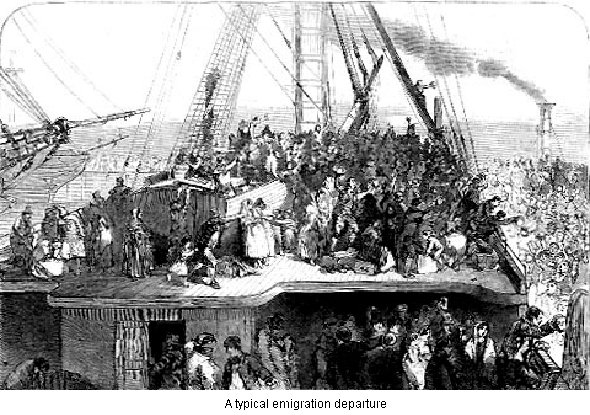Journal Volume 5 2006
Surplus People from Newcastle and Ballyvolan (continued/4)
The Fitzwilliam clearance policy ran from 1847 to 1856, and almost 6,000 'surplus' tenants sailed for Canada, mostly arriving at Quebec on ships such as the Dunbrody, Standard, Pilgrim and other Graves-owned ships, but one ship, the Star, sailed from New Ross to the New Brunswick port of St Andrews.10
Among those 6,000 emigrants were two families from the townland of Newcastle Lower, and one from Ballyvolan:
|
The McGuerry family11 |
(Newcastle Lower): Elizabeth 45, John 27, Catherine 23, Pat 18, Morris 16, Michael 15, Edward 12, Mary 10 months, Mary (again!) 22 months |
|
The Ellis family12 |
(Newcastle Lower): John 50, Hannah 40, Mary 20, Sarah 14, Thomas 11, Eleanor 2 |
|
The Roche family13 |
(Ballyvolan): Michael 50, Eleanor 40, Pat 16, James 14, Thomas 1, Michael Higgins 30 |
All sailed from New Ross on board the Swan on June 9th, 1848 bound for Quebec. The Roches were accompanied by Michael Higgins, 30. There is no record of his relationship to the Roches but was probably a brother of Eleanor, such was often the case. Research through parish registers might confirm or discount this supposition. The fact that all three families were near neighbours and are listed in the 1848 Book in strict sequence (references 163, 164 and 165) reflects the policy of the estate that friends and relatives should travel en bloc when possible. In such groups lay security and strength of purpose.

Without fuller information, it is difficult to determine all the criteria which qualified people for the scheme. There were many cases of individuals not being allowed to accompany their families to Canada. In some instances this was understandable, if a little callous, in that a fourteen or fifteen-year-old son or daughter might be working away from home and was, therefore, not regarded as being dependent on the estate. But what of young children whose names were first added to the list and then scratched off? Why were they rejected? Perhaps in a few cases they had died between the time their names had been given and the time of departure. It is just not possible to say. There were quite a few 'foundlings' and in most of these cases supporting evidence that the child had been cared for by the family had to be produced. A letter from a priest was deemed sufficient proof.
Any land holding, whether it consisted of a kitchen garden, ten acres or fifty, was to be incorporated into larger neighbouring holdings. In some cases, the recipient of the holding was expected to pay at least some of the costs of emigrating the departing family. For example, Mr Brewster of Ballynultagh agreed to pay half of the expenses of sending John Byrne and his family to Canada because he was to take over Byrne's six acres. In the majority of cases incorporation simply meant that the sublet holdings reverted to the immediate lessor.
In other parts of Ireland, tenants who increased their holdings by incorporating the holdings of evicted or otherwise departing tenants were sometimes ostracised by the local community, but this does not seemed to have happened on the Fitzwilliam estate. If there was even one case of retribution for such incorporation I have not been able to find it. Perhaps it was the fact that unadorned eviction was not usually resorted to by Fitzwilliam, and a tenant’s departure was more or less voluntary.


